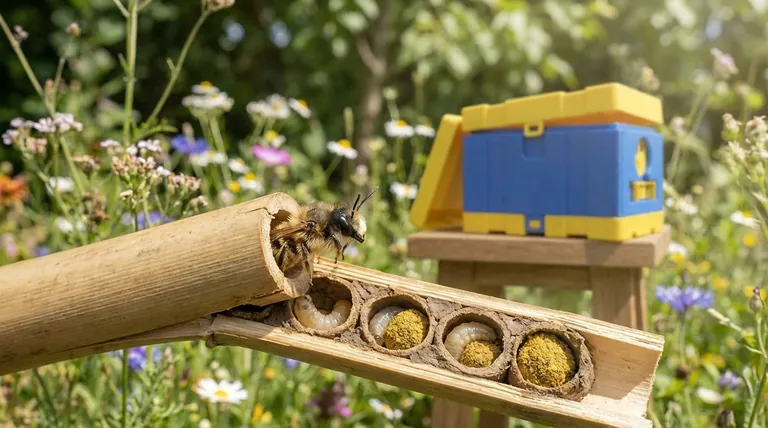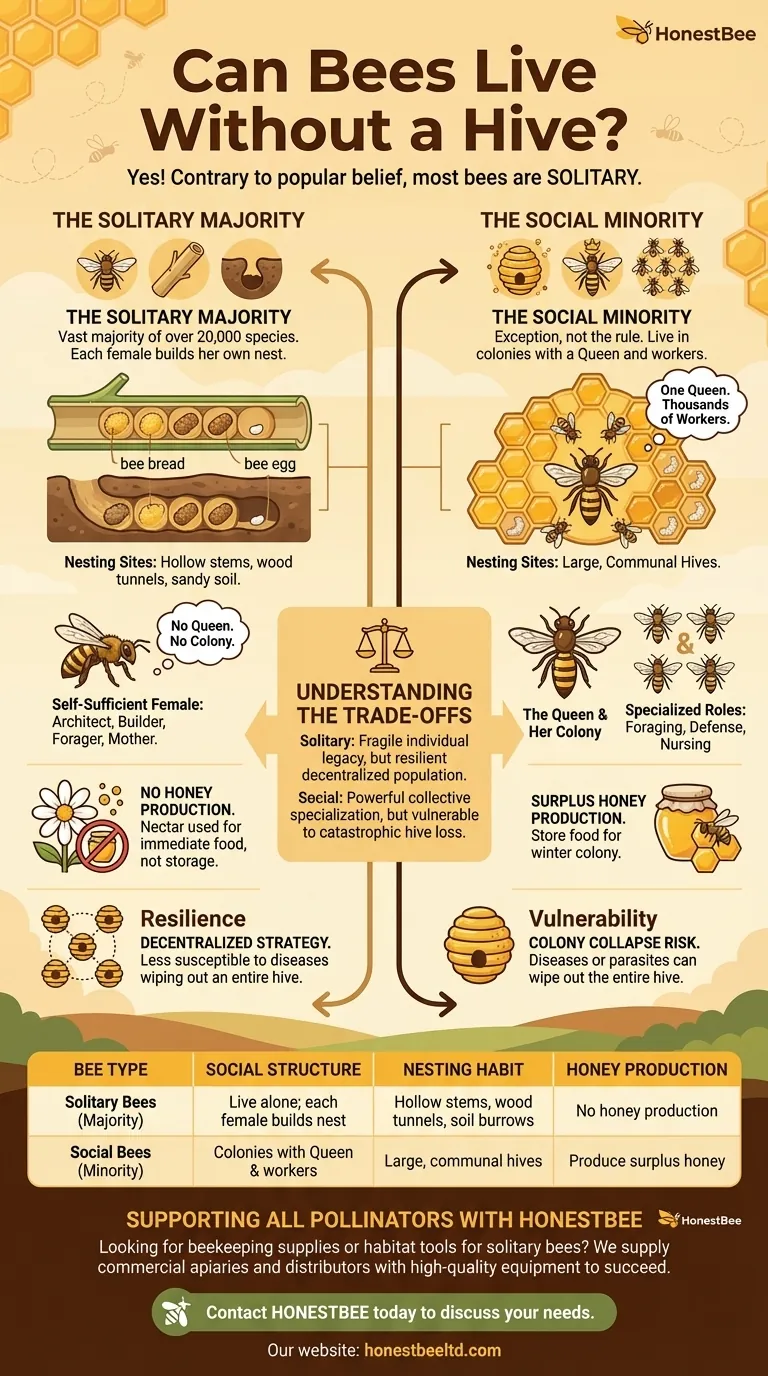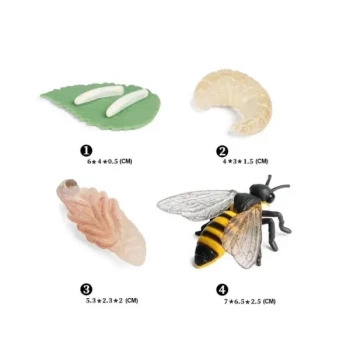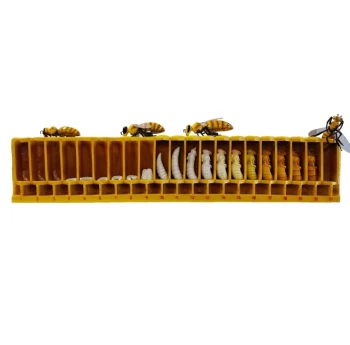Contrary to the popular image, most bee species on Earth live entirely without a hive. The vast majority of bees are solitary, meaning each female builds and provisions her own nest without the support of a queen or a colony of workers.
The concept of a bee is often conflated with that of the honey bee, but this is a misconception. Hive-living is the exception, not the rule, in the world of over 20,000 bee species.

Beyond the Hive: A Look at Bee Diversity
The image of a bustling hive with a queen and thousands of workers represents only a small fraction of bees, primarily honey bees and bumblebees. To truly understand bees, we must look at the far more common solitary lifestyle.
The Solitary Bee Strategy
Solitary bees, as their name implies, live alone. Each female is fertile and responsible for building her own nest, gathering food, and laying her eggs without any cooperation from other bees.
They do not have a queen or a caste of sterile workers. Their life's mission is singularly focused on creating the next generation before their own short life ends.
Where Do Solitary Bees Nest?
Instead of a large, communal hive, solitary bees create individual nests in a variety of places. Common nesting sites include:
- Hollow stems from plants like reeds or bamboo
- Tunnels bored into wood
- Small burrows excavated in dry, sandy soil
While they live alone, many species are "gregarious," meaning they build their nests near one another, similar to how people live in a neighborhood of single-family homes.
The Life of a Solitary Bee
The absence of a hive and a queen creates a fundamentally different life cycle and set of behaviors compared to the well-known honey bee.
The Self-Sufficient Female
A solitary female bee performs every role herself. She is the architect, the builder, the forager, and the mother.
She builds a series of small cells within her nest. In each cell, she places a ball of pollen mixed with nectar (often called "bee bread"), lays a single egg on it, and then seals the cell.
No Honey, No Problem
Solitary bees do not produce honey. The nectar they collect is used exclusively to create the pollen provisions needed to feed their own offspring. They do not need to store food for a winter colony because the adult bees typically die before winter arrives.
The new generation develops within the sealed cells, emerging the following year to start the cycle over again.
Understanding the Trade-offs
The solitary and social lifestyles represent two different, but equally successful, evolutionary strategies. Each comes with distinct advantages and disadvantages.
The Vulnerability of Solitude
A solitary bee's legacy is fragile. If the female is caught by a predator or dies before finishing her nest, her entire genetic line for that season is lost. There is no colony to continue her work.
The Power of the Hive
Social colonies, like those of honey bees, benefit from specialization. Having dedicated workers for foraging, defense, and nursing the young allows the colony to accomplish tasks at a massive scale, such as producing surplus honey and mounting a formidable defense.
The Resilience of Being Alone
Solitary bees, however, have their own form of resilience. Because their nests are distributed across the landscape, they are less susceptible to diseases or parasites that can wipe out an entire hive in a single blow. This decentralized strategy prevents catastrophic colony collapse.
Making the Right Choice for Your Goal
Understanding this distinction is key to supporting these vital pollinators, whether you are a gardener, a farmer, or simply a curious observer.
- If your primary focus is supporting local ecosystems: Create habitats for solitary bees, as they are often more efficient pollinators for native plants. This includes leaving patches of bare soil or setting up "bee hotels."
- If your primary focus is honey production: You must work with social honey bees, as they are the only species that produces honey in harvestable quantities.
- If your primary focus is biodiversity: Look for the huge variety of bees in your own backyard; you will find that most of them are solitary bees that do not live in hives.
By looking beyond the hive, you gain a truer appreciation for the incredible diversity and resilience of the world's most important pollinators.
Summary Table:
| Bee Type | Social Structure | Nesting Habit | Honey Production |
|---|---|---|---|
| Solitary Bees (Majority) | Live alone; each female builds her own nest | Hollow stems, wood tunnels, soil burrows | No honey production |
| Social Bees (Minority) | Live in colonies with a queen and workers | Large, communal hives | Produce surplus honey |
Looking to support all types of pollinators?
At HONESTBEE, we supply the beekeeping supplies and equipment that commercial apiaries and distributors need to succeed. Whether you manage honey bee hives or want to create habitats for essential solitary bees, our wholesale-focused operations provide the reliable, high-quality tools for your goals.
Contact HONESTBEE today to discuss your specific needs and discover how our products can help your operation thrive.
Visual Guide

Related Products
- 4 Frame Plastic Nuc Boxes for Beekeeping Bee Nuc Box
- Superhero Bee Mascot Costume Dynamic Professional Brand Champion Costume
- Yellow Plastic Bucket Pail Perch for Beekeeping
- High Performance Cordless Electric Bee Shaker for Beekeeping
- Heavy-Duty Stainless Steel Frame Perch
People Also Ask
- How does colony growth differ between nucs and bee packages? A Guide to Faster Beehive Buildup
- What should a healthy brood nest in a nuc look like? A Guide to Strong Colony Development
- What is the recommended time of year to move bee nucs to a 10-frame hive? A Guide for Apiary Success
- What are the advantages of choosing a nucleus hive over a package of bees? Get a Head Start with a Pre-Established Colony
- What are nucleus colonies (nucs) and how do they compare to full-size Langstroth colonies?



















